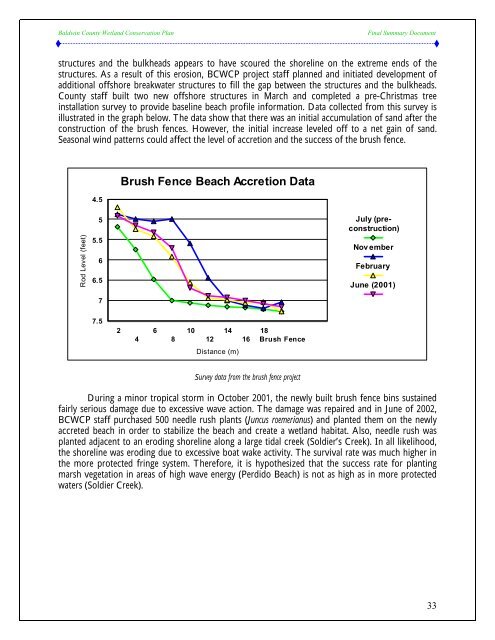Baldwin County Wetland Conservation Plan - Alabama Department ...
Baldwin County Wetland Conservation Plan - Alabama Department ...
Baldwin County Wetland Conservation Plan - Alabama Department ...
Create successful ePaper yourself
Turn your PDF publications into a flip-book with our unique Google optimized e-Paper software.
<strong>Baldwin</strong> <strong>County</strong> <strong>Wetland</strong> <strong>Conservation</strong> <strong>Plan</strong> Final Summary Document<br />
structures and the bulkheads appears to have scoured the shoreline on the extreme ends of the<br />
structures. As a result of this erosion, BCWCP project staff planned and initiated development of<br />
additional offshore breakwater structures to fill the gap between the structures and the bulkheads.<br />
<strong>County</strong> staff built two new offshore structures in March and completed a pre-Christmas tree<br />
installation survey to provide baseline beach profile information. Data collected from this survey is<br />
illustrated in the graph below. The data show that there was an initial accumulation of sand after the<br />
construction of the brush fences. However, the initial increase leveled off to a net gain of sand.<br />
Seasonal wind patterns could affect the level of accretion and the success of the brush fence.<br />
Rod Level (feet)<br />
4.5<br />
5<br />
5.5<br />
6<br />
6.5<br />
7<br />
7.5<br />
2<br />
Brush Fence Beach Accretion Data<br />
4<br />
6<br />
8<br />
10 14<br />
12<br />
Distance (m)<br />
16<br />
18<br />
Brush Fence<br />
Survey data from the brush fence project<br />
July (preconstruction)<br />
Nov ember<br />
February<br />
June (2001)<br />
During a minor tropical storm in October 2001, the newly built brush fence bins sustained<br />
fairly serious damage due to excessive wave action. The damage was repaired and in June of 2002,<br />
BCWCP staff purchased 500 needle rush plants (Juncus roemerianus) and planted them on the newly<br />
accreted beach in order to stabilize the beach and create a wetland habitat. Also, needle rush was<br />
planted adjacent to an eroding shoreline along a large tidal creek (Soldier’s Creek). In all likelihood,<br />
the shoreline was eroding due to excessive boat wake activity. The survival rate was much higher in<br />
the more protected fringe system. Therefore, it is hypothesized that the success rate for planting<br />
marsh vegetation in areas of high wave energy (Perdido Beach) is not as high as in more protected<br />
waters (Soldier Creek).<br />
33

















